Tomahawk
A tomahawk is a type of single-handed ax native to the many Indigenous peoples and nations of North America, traditionally resembling a hatchet with a straight shaft.[1][2] The term came into the English language in the 17th century as an adaptation of the Powhatan (Virginian Algonquian) word.
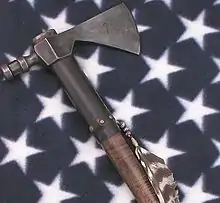
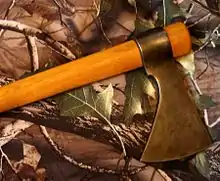
Tomahawks were general-purpose tools used by Native Americans and later the European colonials with whom they traded, and often employed as a hand-to-hand weapon. The metal tomahawk heads were originally based on a Royal Navy boarding ax and used as a trade-item with Native Americans for food and other provisions.[1][2]
Etymology
The name comes from Powhatan tamahaac, derived from the Proto-Algonquian root *temah- "to cut off by tool".[3] Algonquian cognates include Lenape təmahikan,[4] Malecite-Passamaquoddy tomhikon, and Abenaki demahigan, all of which mean "ax".[5][6]
History

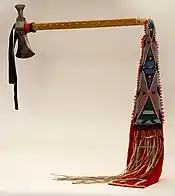
The Algonquians in early America created the tomahawk. Before Europeans came to the continent, Native Americans would use stones attached to wooden handles, secured with strips of rawhide. The tomahawk quickly spread from the Algonquian culture to the tribes of the South and the Great Plains.
When Europeans arrived, they introduced the metal blade to the natives, which improved the effectiveness of the tool. Metal did not break as readily as stone and could be fashioned for additional uses. Native Americans created a tomahawk’s poll, the side opposite the blade, which consisted of a hammer, spike or a pipe. These became known as pipe tomahawks, which consisted of a bowl on the poll and a hollowed out shaft.[7] These were created by European and American artisans for trade and diplomatic gifts for the tribes.[8]
Composition
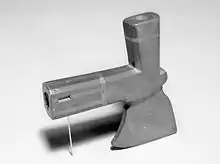
Pre-contact Native Americans lacked the technology for the hot-forging of metal, so tomahawks were not fitted with metal ax heads until they were obtained from trade with Europeans. The tomahawk's original designs were fitted with heads of bladed or rounded stone or deer antler.[3][9]
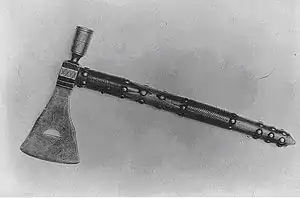
The modern tomahawk shaft is usually less than 2 ft (61 cm) in length, traditionally made of hickory, ash, or maple.[1][2][10] The heads weigh anywhere from 9 to 20 oz (260 to 570 g), with a cutting edge usually not much longer than four inches (10 cm) from toe to heel.[2] The poll can feature a hammer, spike, or may simply be rounded off, and they usually do not have lugs.[1][2] These sometimes had a pipe-bowl carved into the poll, and a hole drilled down the center of the shaft for smoking tobacco through the tomahawk.[2] There are also metal-headed versions of this unusual pipe.[2] Pipe tomahawks are artifacts unique to North America: created by Europeans as trade objects but often exchanged as diplomatic gifts.[1] They were symbols of the choice Europeans and Native Americans faced whenever they met: one end was the pipe of peace, the other an ax of war.[1][2][10]
In colonial French territory, a different tomahawk design, closer to the ancient European francisca, was in use by French settlers and indigenous peoples.[10] In the late 18th century, the British Army issued tomahawks to their colonial regulars during the American Revolutionary War as a weapon and tool.[11]
Modern use
Tomahawks are useful in camping and bushcraft scenarios. They are mostly used as an alternative to a hatchet, as they are generally lighter and slimmer than hatchets. They often contain other tools in addition to the ax head, such as spikes or hammers.[12]

Modern tomahawks were used by selected units of the US armed forces during the Vietnam War and are referred to as "Vietnam tomahawks".[13][14] These modern tomahawks have gained popularity with their reemergence by American Tomahawk Company in the beginning of 2001 and a collaboration with custom knife-maker Ernest Emerson of Emerson Knives, Inc.[13] A similar wood handle Vietnam tomahawk is produced today by Cold Steel.[13]
Many of these modern tomahawks are made of drop forged, differentially heat treated, alloy steel.[15] The differential heat treatment allows for the chopping portion and the spike to be harder than the middle section, allowing for a shock-resistant body with a durable temper.[15]
Tomahawk throwing competitions
Tomahawk throwing[16] is a popular sport among American and Canadian historical reenactment groups, and new martial arts such as Okichitaw have begun to revive tomahawk fighting techniques used during the colonial era.[17] Tomahawks are a category within competitive knife throwing. Today's hand-forged tomahawks are being made by master craftsmen throughout the United States.[13][18]
Today, there are many events that host tomahawk throwing competitions.[19]
The tomahawk competitions have regulations concerning the type and style of tomahawk used for throwing. There are special throwing tomahawks made for these kinds of competitions. Requirements such as a minimum handle length and a maximum blade edge (usually 4 in [100 mm]) are the most common tomahawk throwing competition rules.[19]
Military application
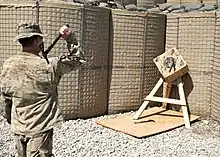
Tomahawks were used by the US Army Stryker Brigade in Afghanistan, the 172nd Stryker Brigade Combat Team based at Grafenwöhr (Germany), the 3rd Brigade, 2nd Infantry Division out of Fort Lewis, a reconnaissance platoon in the 2d Squadron 183d Cavalry (116th Infantry Brigade Combat Team) (OIF 2007–2008) and numerous other soldiers.[13][15] The tomahawk was issued a NATO stock number (4210-01-518-7244) and classified as a "Class 9 rescue kit" as a result of a program called the Rapid Fielding Initiative; it is also included within every Stryker vehicle as the "modular entry tool set".[13][15] This design enjoyed something of a renaissance with US soldiers in Iraq and Afghanistan as a tool and in use in hand-to-hand combat.[20]
Law enforcement
The tomahawk has gained some respect from members of various law enforcement tactical (i.e. "SWAT") teams. Some companies have seized upon this new popularity and are producing "tactical tomahawks". These SWAT-oriented tools are designed to be both useful and relatively light. Some examples of "tactical tomahawks" include models wherein the shaft is designed as a prybar. There are models with line/rope cutting notches, cuts in the head allowing its use as a wrench, and models with broad, heavy heads to assist in breaching doors.[21]
Modern tomahawk fighting
There are not many systems worldwide which teach fighting skills with the ax or a tomahawk to civilians. However one martial art known as Okichitaw teaches tomahawk fighting in conjunction with other indigenous weapons such as the plains dagger, lance and gunstock war club, mostly based on Plains Indian combat principles. In the 21st century, tomahawks have been prominently featured in films and video games (e.g. The Patriot; Abraham Lincoln: Vampire Hunter;[22] Bullet to the Head; Assassin's Creed III),[23][24] leading to increased interest among the public. Tomahawks are among the weapons used in the Filipino martial art escrima.[25]
Manufacturers
Modern tomahawk manufacturers include:
- American Tomahawk Company
- Benchmade Knife Company
- SOG Specialty Knives
- Gerber Legendary Blades
- Cold Steel
- Winkler Knives
- L.C. Hansen
- RMJ Tactical
- Mccoun Blades
See also
References
- Haskew, Mike (2003-09-01). "Pipe Hawks". Blade Magazine. 30 (9): 26–34.
- Haskew, Mike (2006-09-01). "Star-Spangled Hawks Take Wing". Blade Magazine. 33 (9): 30–37.
- Cutler, Charles L. (2002). Tracks that Speak: The Legacy of Native American Words in North American Culture. Boston: Houghton Mifflin Harcourt. p. 139. ISBN 0-618-06509-1.
- "tëmahikàn". Lenape Talking Dictionary. Retrieved October 27, 2012.
The Lenape root təmə- means 'to cut off' and the suffix -hikan forms the names of tools
- Hranicky, William (1 April 2009). Material Culture from Prehistoric Virginia. AuthorHouse. p. 56. ISBN 978-1-4389-6661-8.
- Jahr, Ernst Håkon; Broch, Ingvild (1996). Language Contact in the Arctic: Northern Pidgins and Contact Languages. Walter de Gruyter. p. 295. ISBN 978-3-11-014335-5.
- Shannon, Timothy J. (2005). "Queequeg's Tomahawk: A Cultural Biography, 1750-1900". Ethnohistory. Gettysburg College. 52 (3): 589–633. doi:10.1215/00141801-52-3-589 – via The Cupola: Scholarship at Gettysburg College.
- "Tomahawk History". Hawk Throwing. Retrieved 22 July 2014.
- Taylor, Colin F. (2001). Native American Weapons. Norman, Okla.: University of Oklahoma Press. p. 30. ISBN 0806133465. Retrieved 2012-11-17.
The wooden ballheaded club at this time was also generally referred to as a 'tomahawk'
- Haskew, Mike (2004-09-01). "Legends and Lore Through the Spike Tomahawk". Blade Magazine. 28 (9): 12–19.
- Dick, Steven (2002-05-01). "Frontier Hatchets still On Duty". Tactical Knives. 10 (5): 43–47.
- Fadala, Sam (2006). The Complete Blackpowder Handbook. Iola, Wisconsin: Gun Digest Books. p. 348. ISBN 0-89689-390-1.
- Steele, David E. (September 2005). "Wedged Edges at War". Blade Magazine: 12–19.
- "Marines Stuck On Tomahawk" (PDF). The Pittsburgh Press. February 25, 1968. p. 2. Archived from the original (PDF) on August 25, 2006. Retrieved July 14, 2008.
- Emerson, Ernest (2007). "The Modern Tomahawk". American Handgunner: 15.
- "How to Throw a Tomahawk". Hatchets and Axes. February 23, 2011. Retrieved May 3, 2011.
- Taillon, Joan (September 1, 2004). "Toronto martial arts group visits North Korea". The Aboriginal Newspaper of Ontario. 3 (8). p. 2. Retrieved July 20, 2008.
- "Tomahawk Makes Front Page News in San Francisco" (PDF). Mountaineer-Herald. January 25, 1968. p. 8. Archived from the original (PDF) on August 22, 2006. Retrieved July 14, 2008.
- "Tomahawk Throwing Competitions". Hatchets and Axes. March 30, 2012. Archived from the original on June 13, 2014. Retrieved December 8, 2017.
- Tillett, David (April 15, 2003). "Lethal Weapon:Historic Tomahawk Returns to the Battlefield with Some U.S. Troops". ABC News. Retrieved January 24, 2007.
- Kaplan, Steven J. (27 December 2010). TAIHO-JUTSU: The Art of Arrests. Xlibris Corporation. p. 216. ISBN 978-1-4653-2508-2.
- Grahame-Smith, Seth (March 2, 2010). Abraham Lincoln, Vampire Hunter. New York: Grand Central Publishing. p. 336. ISBN 978-0-446-56308-6. OCLC 458890478.
- Assassin's Creed III - Strategy Guide. Game Guide. October 28, 2015. p. 125. ISBN 9781621545316.
- Altson, John; Lee, Bob (January 29, 2013). The Id from Eden. p. 89. ISBN 9781482021271.
- McLemore, Dwight C. (2010). The Fighting Tomahawk. Boulder, Colorado: Paladin Press. p. 27. ISBN 978-1-58160-729-1.